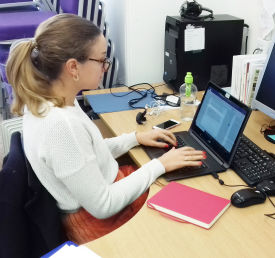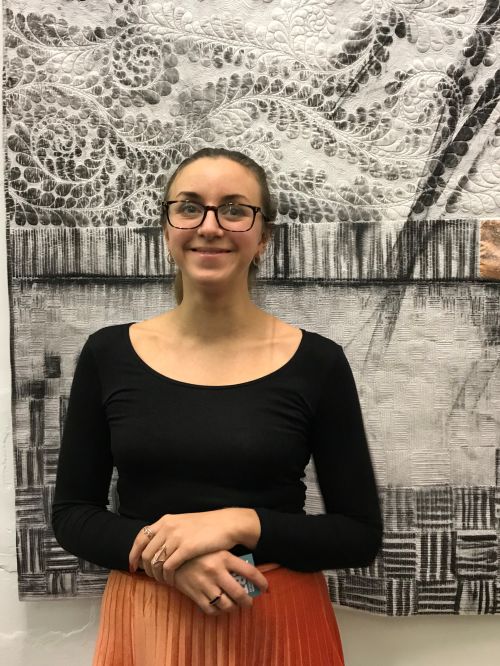Planning an exhibition - a student curator's perspective
Published: Monday, 5th February 2018 16:18 PM

Our most recent exhibition, Contemporary Inspirations was curated by Cat Evans, a PhD student from Sheffield University who specialises in Renaissance Literature. Read on to discover her experience of curating a quilt exhibition with us at The Quilters' Guild, York.
Planning an exhibition - Contemporary Inspirations
On a bright, frosty January morning, I skidded my way along the icy bank of the River Ouse to make my way to the Quilters’ Guild. Over the next few weeks I would be taking a crash course in all things quilt related and curating the next Friends of the Collection exhibition, Contemporary Inspirations. I’d never really had much experience with quilting beyond wondering what a log cabin quilt was in Anne of Green Gables. Normally I spend most of my time reading and teaching Renaissance Literature for my PhD at the University of Sheffield, so this project would push me well outside my comfort zone. The first few days were spent browsing the books in the well-stocked Guild library: sorting out my tops from my quilts and breezing through 400 years of textiles history under the expert guidance of Heather Audin, Curator of the Quilt Collection.
Next it was time to explore the collections. I was amazed at the breadth of the holdings: more than 800 pieces are carefully stored at St. Anthony’s Hall, from the oldest surviving piece of patchwork, the 1718 Silk Patchwork Coverlet, to quilts completed only last year. Searching through the collection database threw up dozens of beautiful, intriguing quilts made in the last twenty years - the real issue would be choosing just a few pieces from this embarrassment of riches to fit into the compact exhibition space available.
As I whittled down my list, I began to see themes reoccurring. In the last twenty years there has been a general trend towards quilts that make use of printing techniques on wholecloth. As the collection includes several of Pauline Burbidge’s quilts, this movement was particularly noticeable in her output. Over the years, her style has developed from geometric, patchwork pieces to large scale “quiltscapes†that made use of different forms of printing, overlaid with different materials to add texture and variety.
I decided that one of the collections newest acquisitions by Pauline, Honesty Skyline, would be an ideal piece to introduce the theme of printing. Honesty Skyline pairs stark rubbings of red hot poker plants with a subtly dyed pattern of honesty seed pods, produced by cyanotype printing. This form of printing was discovered in 1842 by Sir John Herschel. It was one of the earliest forms of photography, using the light of the sun to create images on paper or cloth. Fabric impregnated with Potassium Ferricyanide is exposed to sunlight, with some areas blocked off to create an image. When the material is washed in Potassium Ammonium Citrate, the unblocked areas turn vivid Prussian Blue.
Other pieces that foregrounded printing included Mary Mayne’s Laces, which features prints made from trainer soles, and Helen Parrott’s Ilkley Moor 1981. Helen visited the exhibition and pointed out to me that in the 90s this focus on dyeing was often due to necessity, as the range of fabrics available in marbled colourways was very limited. It was wonderful to have this insight from an artist: as a non-quilt maker I hadn’t considered how decisions that seemed based on aesthetics could have had very practical origins.
One particularly striking piece that I knew I wanted to include in the exhibition was Michele Walker’s Field Force. A massive, three-meter long expanse of green constructed from recycled plastic bags, this piece takes elements of the traditional Strippy quilt and reworks them. Representing the South Downs, the plastic is quilted in a complex pattern based on tyre treads, mirrored to appear almost like paisley. Walker created the quilt in response to the destruction of the landscape around her home by industrial farming. I was struck by how effective this sort of political commentary is when made through the traditionally homely, comforting medium of a quilt. I paired this with Cherry Vernon-Harcourt’s Summer in the City, an homage to the semi-wild spaces on the fringes of cities.
In all there were fifteen quilts displayed, as well as some smaller pieces. Fitting them in to the library was a challenge - two days spent on step ladders clutching screwdrivers, nails, and fishing-line, and sawing wood to hang the quilts from. Whilst the exhibition was only on for five days, we were pleased that around 70 people visited, many of them previous friends of the museum who we’d individually mailed. Excitingly, many wished to become Friends of the Collection, allowing this new venture to expand.
Whilst this is the only exhibition I will have a hand in, I’m excited to see the next, Unfinished Pieces, which will again be curated by a locally based PhD student. This is part of an ongoing collaboration between The Quilters’ Guild and the White Rose Universities (Sheffield, Leeds and York). As a Doctoral Researcher, you normally spend most of your time alone, working on ever more specific archival material in a project that can feel somewhat disconnected from the rest of the world. Learning how to present information through objects as well as texts in an accessible and engaging way, whilst taking into consideration the various needs of Guild members and staff was a valuable challenge, and one that I’ll carry with me going forward.
Cat Evans.
 Cat Evans in front of Laura Kemshall's And Now the Weather...(2008)
Cat Evans in front of Laura Kemshall's And Now the Weather...(2008)